Download this report (Feb. 2016; 10 pages; pdf)
Paid sick leave is critical for families for health care and economic reasons. Parents should not be forced to choose between caring for themselves or family members and their jobs. The lack of paid sick leave adds stress to families, exposes co-workers unnecessarily, and risks the spread of infectious diseases to children in schools and child care centers. As with other employee-provided benefits, such as health insurance and paid vacation, paid sick leave tends to be less available in lower-wage jobs.
Therefore, those who can least afford to lose any of their income are the most likely to have to choose between working and taking time to care for themselves or a child when they are sick. This intersection of low-wage work and the lack of benefits like paid sick leave helps keep the working poor from climbing out of their situation.
Guaranteeing all workers at least one week of paid sick leave would do much to help low-income working families and their children. In New Mexico, however, only half of private-sector workers have access to paid sick leave. This is the worst rate in the nation.1 New Mexico, with its high percentage of low-wage jobs and a correspondingly high rate of working families who are low-income, would have much to gain from enacting paid leave legislation.
The lack of paid leave is a national problem. On January 20, 2015, in the State of the Union address, President Obama highlighted the need for paid sick leave in the United States:
- “…today, we are the only advanced country on Earth that doesn’t guarantee paid sick leave or paid maternity leave to our workers. Forty-three million workers have no paid sick leave―43 million. Think about that. And that forces too many parents to make the gut-wrenching choice between a paycheck and a sick child at home. So I’ll be taking new action to help states adopt paid leave laws on their own.”
The President then called on Congress to send him legislation that would ensure that all workers could earn at least seven days of paid sick leave, saying “it’s the right thing to do.” While there has been no similar call to action at the state level in New Mexico, the Legislature did pass a memorial in 2015 requesting that the Bureau of Business and Economic Research at the University of New Mexico convene a working group to develop recommendations for the establishment of a publicly managed parenting workers’ leave fund. That same year, a broad coalition of grassroots organizing groups, advocates, and labor began pushing the Albuquerque City Council to enact a Fair Work Week ordinance that would ensure all employees would earn one hour of sick leave for every 30 hours worked, among other things. The Albuquerque City Council did not pass it, but it is expected to be introduced again.
There is a substantial body of evidence that supports President Obama’s belief that granting paid sick leave is “the right thing to do.” Paid sick days bring multiple benefits to employers, workers, families, and communities at large.2 The economic and public-health benefits of paid sick leave coverage are substantial, including safer work environments,3 reduced spread of contagion,4 and reduced health care costs.5
Health care costs are reduced because paid sick leave encourages a more rational use of health resources. In a 2011 report, the Institute for Women’s Policy Research found that:
- Paid sick days are associated with better self-reported general health among workers;
- Workers with paid sick days are less likely to delay medical care for themselves or for family members;
- Access to paid sick days is associated with lower usage of hospital emergency departments, a finding that holds true for those workers and families with private health insurance, those with public health insurance (e.g. Medicaid or CHIP), and those with no insurance.6
The Institute for Women’s Policy Research, which puts the estimate of American workers without paid sick leave between 43 million and 48 million, writes that such workers, “…often have to risk their jobs or pay when inevitable short-term health and care-giving needs arise.”7
International Comparison
As the President indicated, the U.S. does not compare well with other advanced nations regarding guaranteed paid sick leave. In 2009, the Center for Economic and Policy Research (CEPR) issued a report called Contagion Nation: A Comparison of Paid Sick Day Policies in 22 Countries. The report notes that the U.S. is the only nation ranked highly in terms of economic and human development that does not guarantee paid sick leave for all workers. The U.S. also has no federal laws protecting workers from being fired if they do miss work due to illness.
The CEPR report compares national policies for two illness scenarios: a case of flu that requires five days off work for recovery and a cancer treatment that requires missing 50 days of work. The report defines the time necessary for recovery from the flu as paid sick days and the time off for cancer treatment as paid sick leave. The U.S. is not the only country with no national policy for paid sick days—Canada and Japan join us in that distinction. While Canada has no national policy for paid sick days, most of its provinces require employers to provide some paid days off during short-term illnesses. Figure I summarizes the findings on the 22 countries.
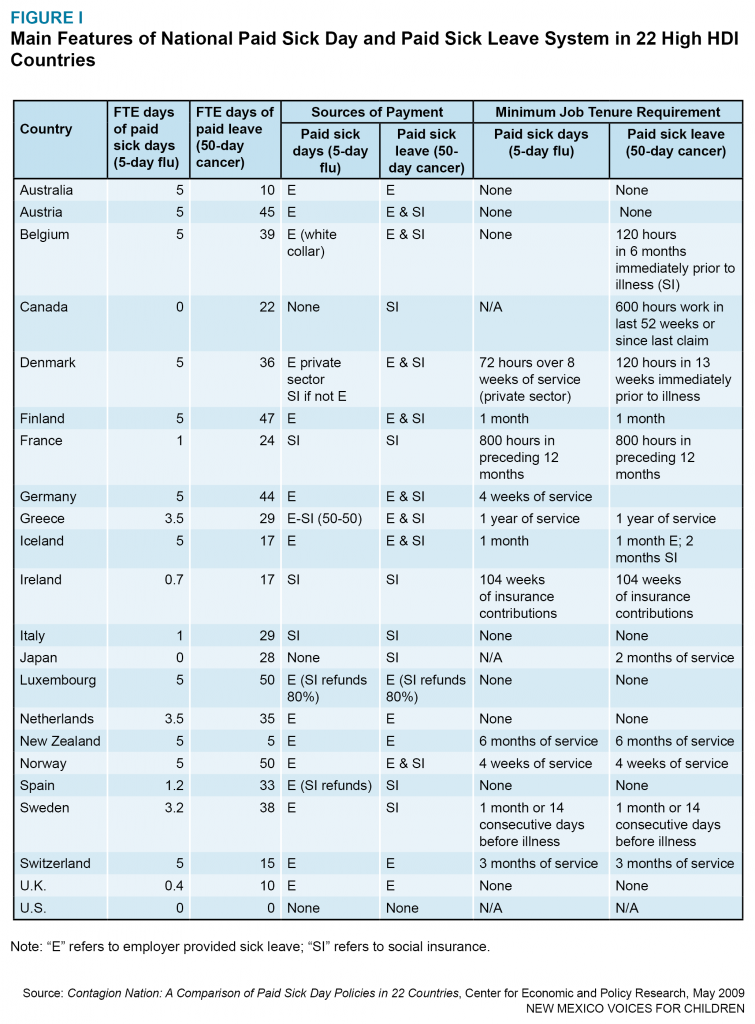
The U.S., however, stands alone as the only country not providing paid sick leave for a long-term illness such as a 50-day cancer treatment. Several nations provide full pay for the 50 working days missed, while others provide less.
There are two ways that governments can approach guaranteeing sick leave to workers. The first method is to mandate that employers provide sick leave to workers. The second method is to include sick days or sick pay in a social insurance system. An employer mandate for sick days is more common in the case of the time needed to recover from a case of flu, while a 50-day cancer treatment is more commonly covered by a countries’ social insurance system. Figure I shows which countries use employer mandates and which countries use the social insurance system model. It also shows what, if any, requirements must be met before employees are eligible.
Paid Sick Leave: The National Picture
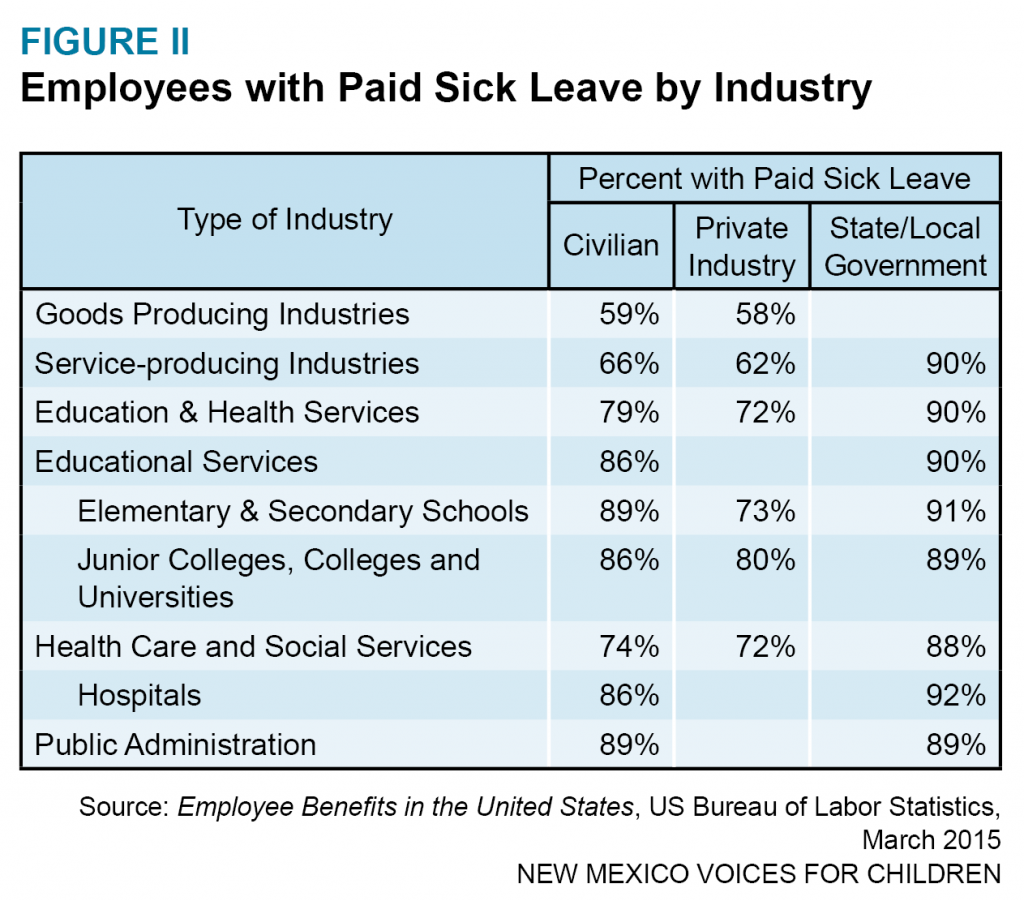 The fact that the United States does not have national legislation requiring sick leave through an employer mandate or a social insurance system does not mean that no sick leave is offered by employers in the U.S. The outcome of availability of paid sick leave in the U.S. is the result of agreements between employers and workers at the individual employer level. Not surprisingly, then, paid sick leave is more common in high-wage and union jobs, as are other employment benefits such as health insurance and paid vacation time. The National Compensation Survey (NCS) of the U.S. Bureau of Labor Statistics provides a broad description of the availability of sick days in the U.S. (Figure II).
The fact that the United States does not have national legislation requiring sick leave through an employer mandate or a social insurance system does not mean that no sick leave is offered by employers in the U.S. The outcome of availability of paid sick leave in the U.S. is the result of agreements between employers and workers at the individual employer level. Not surprisingly, then, paid sick leave is more common in high-wage and union jobs, as are other employment benefits such as health insurance and paid vacation time. The National Compensation Survey (NCS) of the U.S. Bureau of Labor Statistics provides a broad description of the availability of sick days in the U.S. (Figure II).
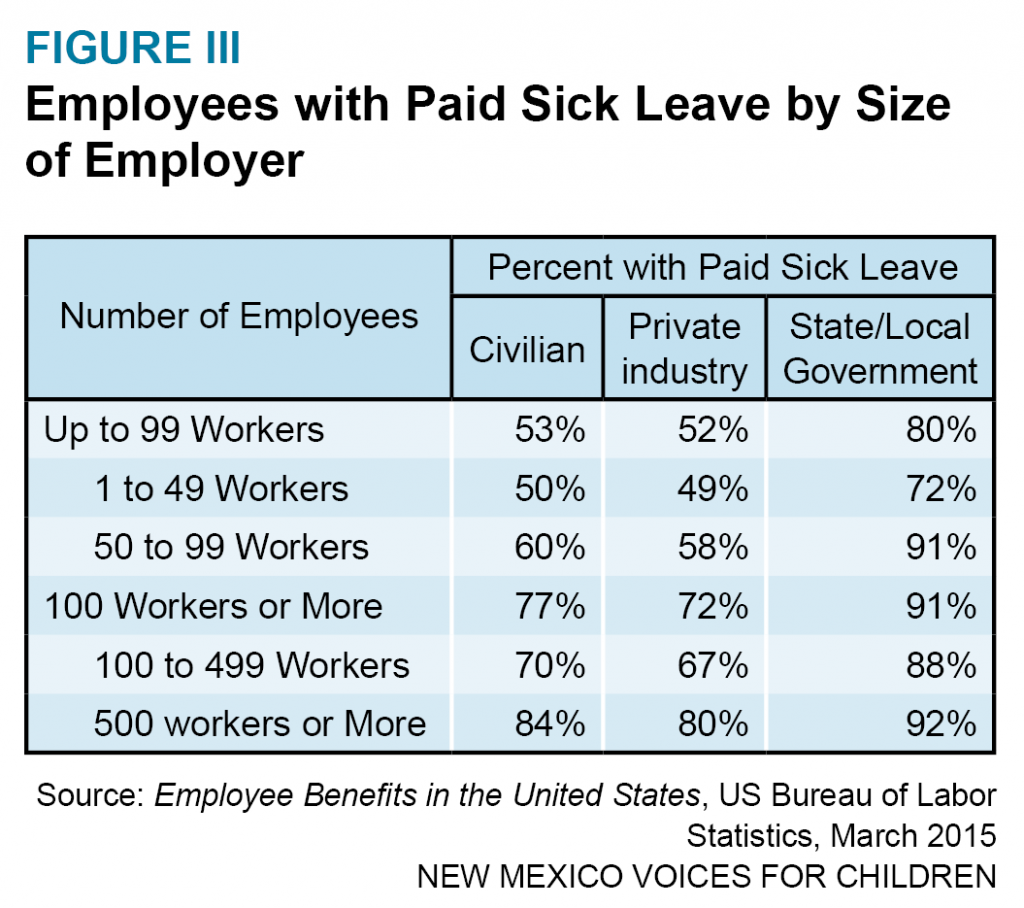 As one would expect, a far lower share of employees receive paid sick leave in industries where most of the jobs do not require a college education—such as goods-producing industries (factories and food processing plants) and in service-producing industries (retail, food service and hospitality). It should be a national concern that so many of the workers who handle our nation’s food supply do not have access to paid sick leave. By far the highest share of employees with paid sick leave work in government. This is, in part, because many of those are union jobs and jobs that require post-secondary education.
As one would expect, a far lower share of employees receive paid sick leave in industries where most of the jobs do not require a college education—such as goods-producing industries (factories and food processing plants) and in service-producing industries (retail, food service and hospitality). It should be a national concern that so many of the workers who handle our nation’s food supply do not have access to paid sick leave. By far the highest share of employees with paid sick leave work in government. This is, in part, because many of those are union jobs and jobs that require post-secondary education.
The availability of paid sick leave also varies widely by the size of employer, as shown in Figure III. The pattern is clear: larger employers are much more likely to offer paid sick leave to their workers. In addition, a far higher percentage of public-sector workers than private sector have access to paid sick leave, irrespective of size.
Paid Sick Leave: Race and Ethnicity and Hours Worked
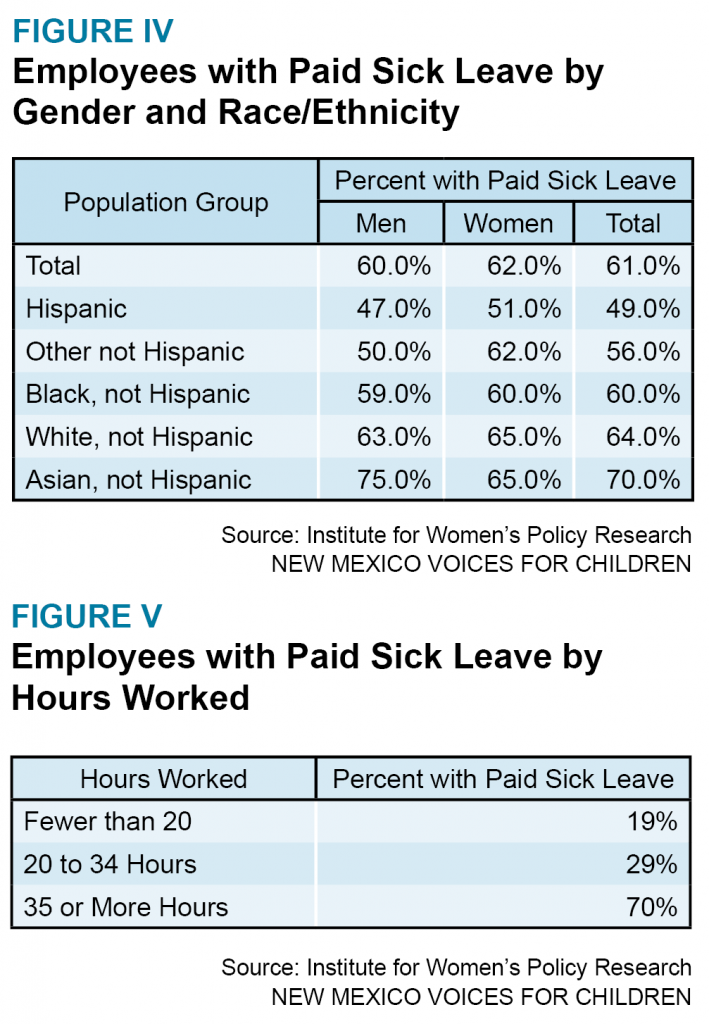 Paid sick days bring multiple benefits to employers, workers, families, and communities at large. The economic and public health benefits of paid sick leave coverage are substantial, including safer work environments, reduced spread of contagion, and reduced health care costs. Access to this important benefit, however, is still too rare, and is unequally distributed across the U.S. population, with substantial differences by race and ethnicity, occupation, earnings levels and work schedules. Differences are also apparent when looking at worker demographics, such as race/ethnicity and gender (see Figure IV). Whites have more access to paid sick leave than Hispanics or Blacks, but less than Asians. The availability of paid sick leave also varies with hours worked, with full-time workers much more likely to have paid sick leave than part-time (see Figure V). This is due to the fact that many employers offering paid sick leave require that employees work a minimum number of hours in order to qualify for it. Also, those working part time are often in low-wage jobs.
Paid sick days bring multiple benefits to employers, workers, families, and communities at large. The economic and public health benefits of paid sick leave coverage are substantial, including safer work environments, reduced spread of contagion, and reduced health care costs. Access to this important benefit, however, is still too rare, and is unequally distributed across the U.S. population, with substantial differences by race and ethnicity, occupation, earnings levels and work schedules. Differences are also apparent when looking at worker demographics, such as race/ethnicity and gender (see Figure IV). Whites have more access to paid sick leave than Hispanics or Blacks, but less than Asians. The availability of paid sick leave also varies with hours worked, with full-time workers much more likely to have paid sick leave than part-time (see Figure V). This is due to the fact that many employers offering paid sick leave require that employees work a minimum number of hours in order to qualify for it. Also, those working part time are often in low-wage jobs.
Paid Sick Leave in the States and Cities
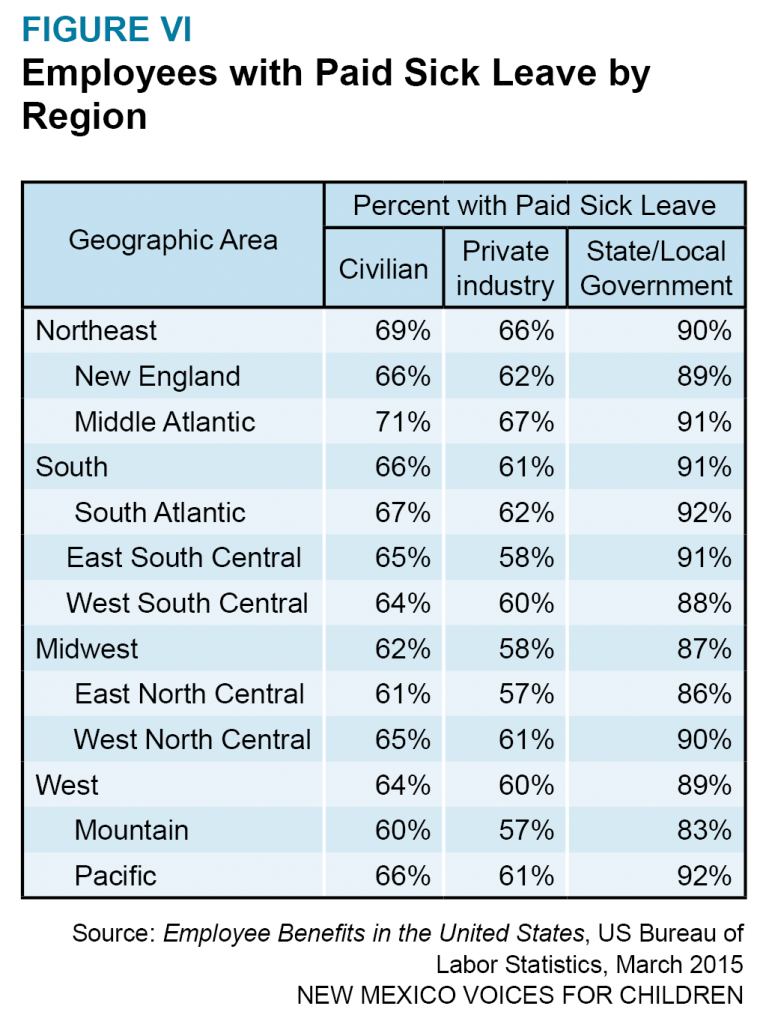 There is also variation in the availability of access to sick leave among the four regions of the United States, as shown in Figure VI. The differences by geographic are not as compelling as differences by industry or hours worked, although it is clear that state and local government employees are far more likely to have paid sick leave benefits, irrespective of geographic location. Overall, workers in the New England and Middle Atlantic areas fare the best.
There is also variation in the availability of access to sick leave among the four regions of the United States, as shown in Figure VI. The differences by geographic are not as compelling as differences by industry or hours worked, although it is clear that state and local government employees are far more likely to have paid sick leave benefits, irrespective of geographic location. Overall, workers in the New England and Middle Atlantic areas fare the best.
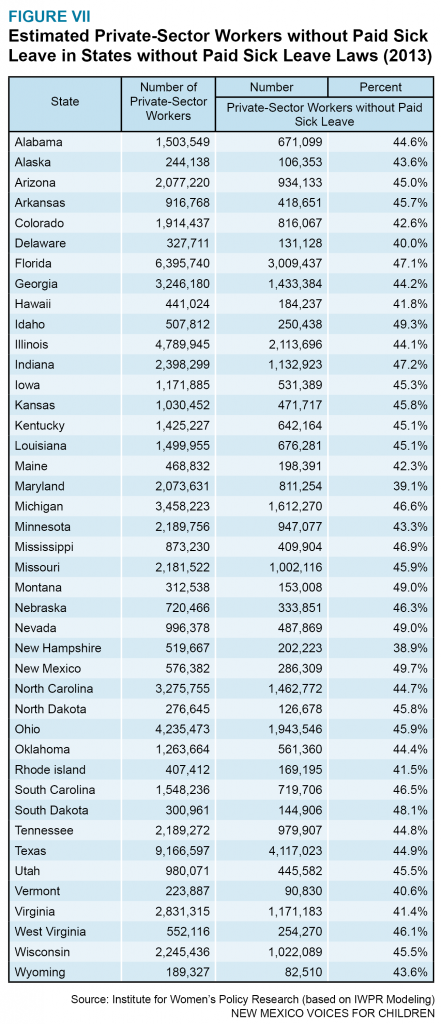 With almost 50 percent of workers without paid sick leave, New Mexico has the highest percentage of workers lacking paid sick days in the United States. Analysis of 2012-2013 data conducted by the Institute for Women’s Policy Research finds that across the country the percentage of workers without paid sick days varies widely from a high of 49.7 percent in New Mexico to a low of 38.9 percent in New Hampshire (see Figure VII). The main reason for New Mexico’s lack of paid sick leave is the high concentration of workers in low-wage employment sectors such as retail trade and hospitality services.
With almost 50 percent of workers without paid sick leave, New Mexico has the highest percentage of workers lacking paid sick days in the United States. Analysis of 2012-2013 data conducted by the Institute for Women’s Policy Research finds that across the country the percentage of workers without paid sick days varies widely from a high of 49.7 percent in New Mexico to a low of 38.9 percent in New Hampshire (see Figure VII). The main reason for New Mexico’s lack of paid sick leave is the high concentration of workers in low-wage employment sectors such as retail trade and hospitality services.
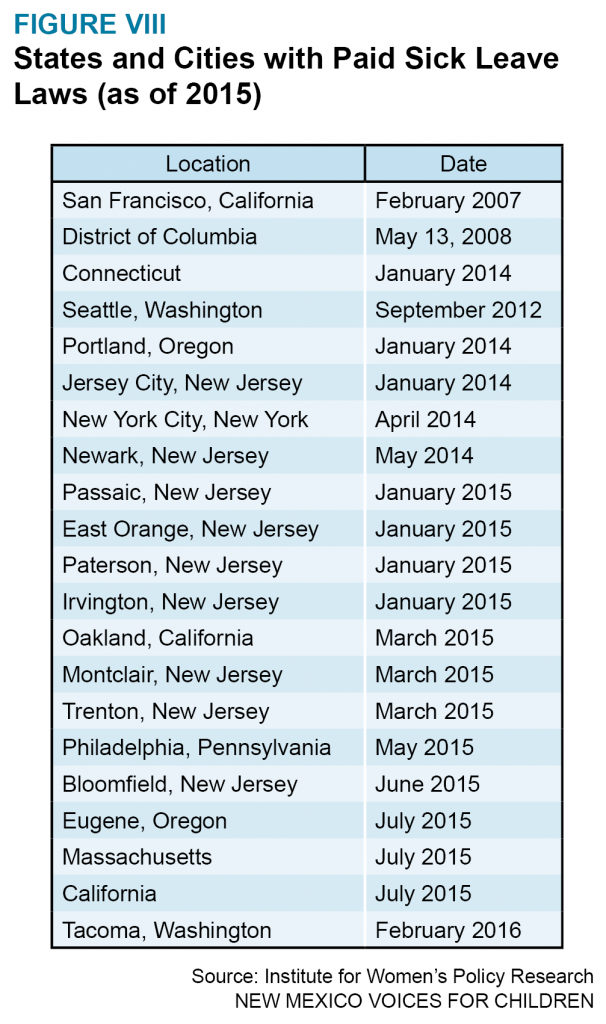 A growing number of cities and states have adopted laws that give workers the right to earn paid sick days (see Figure VIII). Paid sick days laws are in place in California, Connecticut, and Massachusetts, the District of Columbia, and in 17 cities across the country.
A growing number of cities and states have adopted laws that give workers the right to earn paid sick days (see Figure VIII). Paid sick days laws are in place in California, Connecticut, and Massachusetts, the District of Columbia, and in 17 cities across the country.
Paid sick legislation passed in other states provides that workers may not be disciplined, fired or retaliated against for using sick leave. Commonly, workers earn one hour of sick leave for every 30 hours worked with a cap on the number of hours or days that may be earned. Some legislation permits the carryover of unused sick leave each year, also with a cap on the number of hours that may be accrued. It is also common for workers in smaller industries to earn paid sick days at lower rates such as one hour per 40 hours worked or to have lower caps on the number of days or hours that may be accrued. The most worker-friendly laws also allow the leave to be used to care for a sick family member, although these are less common than laws that restrict usage to the workers’ needs.
An Estimate of the Cost of Providing a Week of Paid Sick Leave
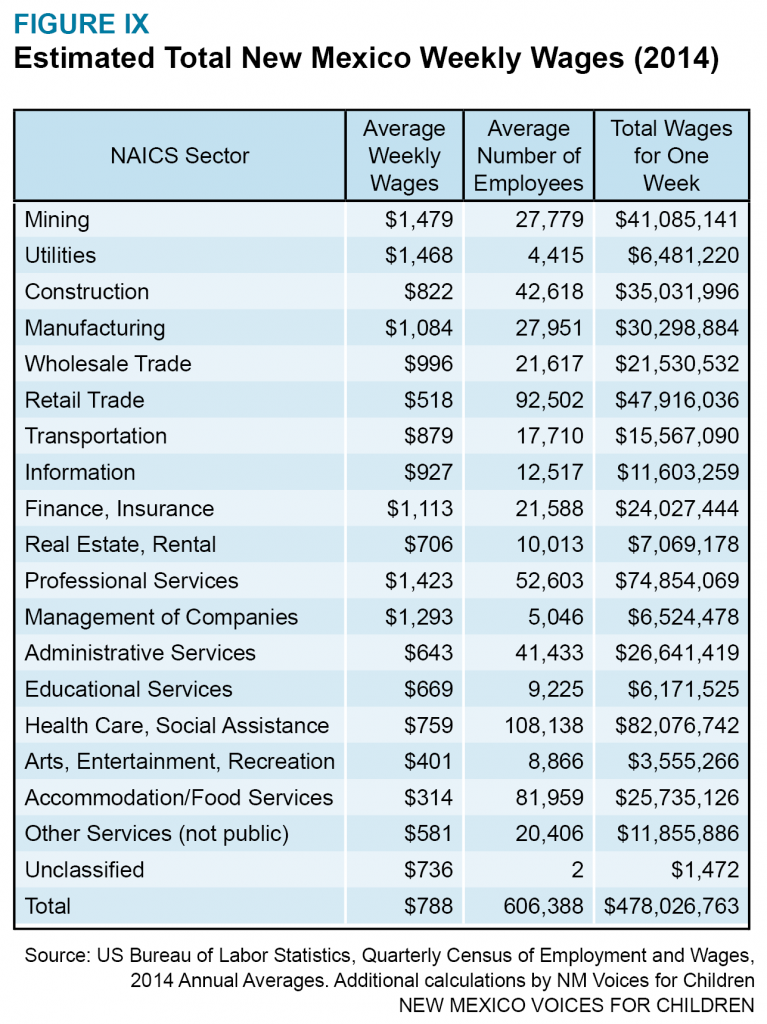 Since barely half of workers in New Mexico have paid sick leave benefits, the cost of mandating such a program is not insignificant. Some of this cost could be offset by productivity enhancements and reduced employee turnover as workers feel less of a need to change jobs. Using data published by the U.S. Bureau of Labor Statistics it is possible to estimate how much a paid sick leave law might cost. New Mexico private-sector wages and employment for 2014 based on major industry classification are given in the first two columns in Figure IX. The total wages for one week―$478 million―are a good proxy for the annual cost of providing one week of sick leave in New Mexico. Since approximately half of all private-sector employees in New Mexico already receive paid sick leave, the annual cost of providing one week of paid leave to those who do not currently have it would be $239 million.
Since barely half of workers in New Mexico have paid sick leave benefits, the cost of mandating such a program is not insignificant. Some of this cost could be offset by productivity enhancements and reduced employee turnover as workers feel less of a need to change jobs. Using data published by the U.S. Bureau of Labor Statistics it is possible to estimate how much a paid sick leave law might cost. New Mexico private-sector wages and employment for 2014 based on major industry classification are given in the first two columns in Figure IX. The total wages for one week―$478 million―are a good proxy for the annual cost of providing one week of sick leave in New Mexico. Since approximately half of all private-sector employees in New Mexico already receive paid sick leave, the annual cost of providing one week of paid leave to those who do not currently have it would be $239 million.
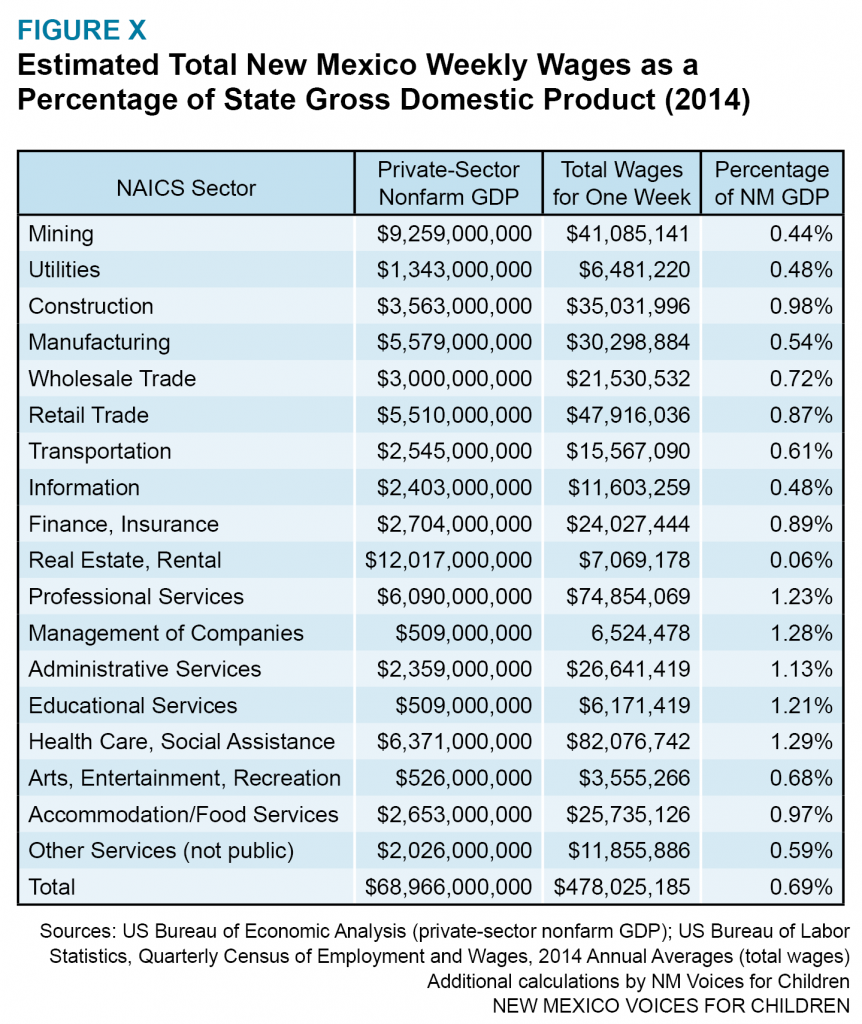 Another way to look at the cost of providing paid sick leave is to look at it as a share of a state’s gross domestic product, or GDP. Each state’s GDP, which is the value of the output of goods and services produced in a state, is estimated by the U.S. Bureau of Economic Analysis (BEA) The New Mexico GDP for the private sector was $69 billion in 2014. Therefore, the cost to the New Mexico private sector of providing one week of sick leave would be $69 billion divided by $239 million or 0.34 percent of private sector GDP (see Figure X). This is a cost that employers could and should easily bear, and state lawmakers should require them to do so.
Another way to look at the cost of providing paid sick leave is to look at it as a share of a state’s gross domestic product, or GDP. Each state’s GDP, which is the value of the output of goods and services produced in a state, is estimated by the U.S. Bureau of Economic Analysis (BEA) The New Mexico GDP for the private sector was $69 billion in 2014. Therefore, the cost to the New Mexico private sector of providing one week of sick leave would be $69 billion divided by $239 million or 0.34 percent of private sector GDP (see Figure X). This is a cost that employers could and should easily bear, and state lawmakers should require them to do so.
Conclusion
In his January 2015 State of the Union address President Obama called for the implementation of paid sick leave on a national basis so that parents are not forced to choose between earning pay and caring for a sick child. That same year the New Mexico state Legislature enacted a memorial to study the feasibility of a publicly managed parenting workers’ leave fund and a coalition pushed the Albuquerque City Council to consider a Fair Work Week initiative.
Several reports have drawn attention to the public health benefits of providing paid sick leave. The lack of paid sick leave results in workers neglecting primary care, which results in more expensive and inappropriate care in hospital emergency departments when the condition becomes acute.
Paid sick days bring multiple benefits to employers, workers, families, and communities at large. The economic and public health benefits of paid sick leave coverage are substantial, including safer work environments, reduced spread of contagion, and reduced health care costs. Access to this important benefit, however, is still too rare, and is unequally distributed across the U.S. population, with substantial differences by race and ethnicity, occupation, earnings levels and work schedules.
Because there is no national policy on paid sick leave, states vary widely on what percentage of workers have paid sick leave available. However, an increasing number of cities and states are mandating that employers provide paid sick leave. New Mexico is the state with the lowest percentage of workers with paid sick leave—about 50 percent. The lack of paid sick leave adds stress to families, exposes co-workers unnecessarily, and risks the spread of infectious diseases to children in schools and child care centers. It also exacerbates the economic troubles for low-income families and makes it harder for them to raise themselves and their children out of poverty.
The annual cost of providing one week of paid sick leave would be approximately $240 million or 0.35 percent of the state’s gross domestic product. This is a cost that employers should and could easily bear. There is obviously much room for New Mexico to do better in providing this important employment support to its workers—a support that would go a long ways to improving the well-being of the state’s families and children.
Endnotes
1. Workers Access to Paid Sick Days in the States, Institute for Women’s Policy Research (IWRP), Washington, DC
2. Valuing Good Health in Newark, Publication No. B324, IWPR, Washington, DC
3. No Time to be Sick: Why Everyone Suffers When Workers Don’t Have Paid Sick Leave, Publication B242, IWRP, Washington, DC
4. “Health, Absence, Disability, and Presenteeism Cost Estimates of Certain Physical and Mental Health Conditions Affecting US Employers,” Journal of Occupational and Environmental Medicine, 46 398-412
5. Paid Sick Days and Health: Cost Savings from Reduced Emergency Department Visits, Publication B301, IWRP, Washington, DC
6. Ibid
7. Workers Access to Paid Sick Days in the States, IWRP

